Abstract
A major problem with pig-to-human-tissue xenograft studies is that humans have natural antibodies to pig cells; these antibodies would cause hyperacute rejection if pig tissues were xenografted to humans. Here we show that most of human IgM antibodies present in the serum of healthy donors and reactive with pig cells react with galactose in an (alpha 1-3) linkage with galactose--i.e., Gal(alpha 1-3)Gal. Absorption studies demonstrated that the antibodies detected the same or similar epitopes on the surface of pig erythrocytes, blood and splenic lymphocytes, and aortic endothelial cells (EC). The antibodies were sensitive to 2-mercaptoethanol (2ME) treatment, did not bind to protein A or G, and were present in the high molecular weight fraction of serum; they are clearly IgM antibodies. Further, the antibodies did not react with human ABO blood group substances and are not related to human blood group A or B, which carry a terminal galactose. The reaction of human serum with pig erythrocytes was specifically inhibited by mono- and disaccharides: D-galactose, melibiose, stachyose, methyl-alpha-D-galactopyranoside, and D-galactosamine but not by D-glucose or methyl-beta-D-galactopyranoside; demonstrating that the reaction is with galactose in an alpha and not a beta linkage. A cDNA clone encoding the murine alpha-1,3-galactosyltransferase (which transfers a terminal galactose residue with an (alpha 1-3) linkage to a subterminal galactose) was isolated by polymerase chain reaction (PCR), cloned, and transfected into COS cells, which are of Old World monkey origin and, like humans, do not express Gal(alpha 1-3)Gal. After transfection, COS cells became strongly reactive with human serum and with IB4 lectin [which reacts only with Gal(alpha 1-3)Gal]; this reactivity could be removed by absorption with pig erythrocytes. As most of the antibody reacting with pig cells can be removed by absorption with either melibiose or Gal(alpha 1-3)Gal+ COS cells, most of these react with Gal(alpha 1-3)Gal. These findings provide the basis for genetic manipulation of the pig alpha-1,3-galactosyltransferase for future transplantation studies.
Full text
PDF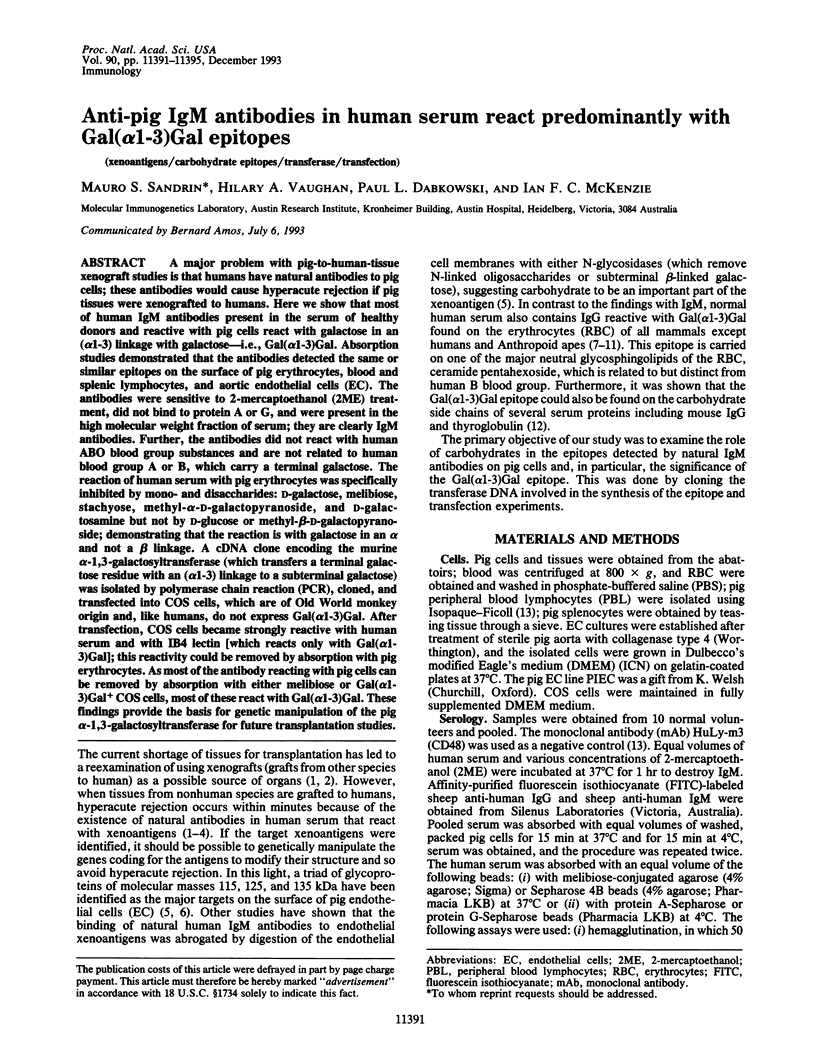
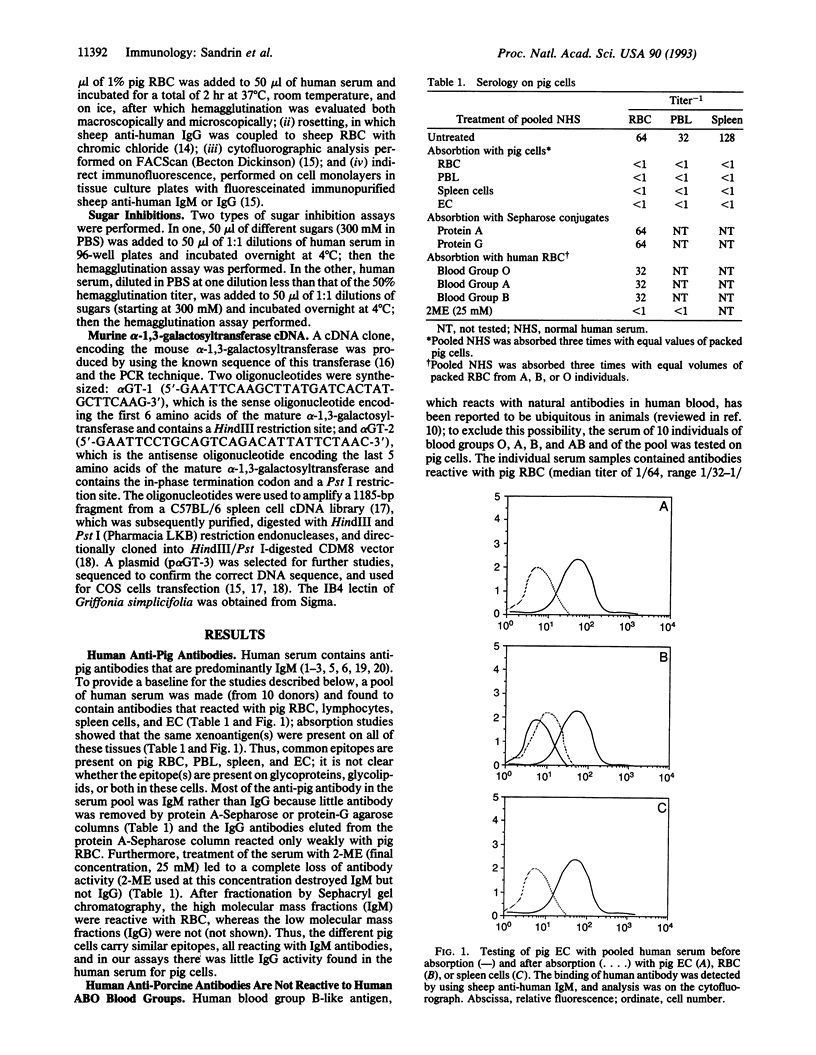
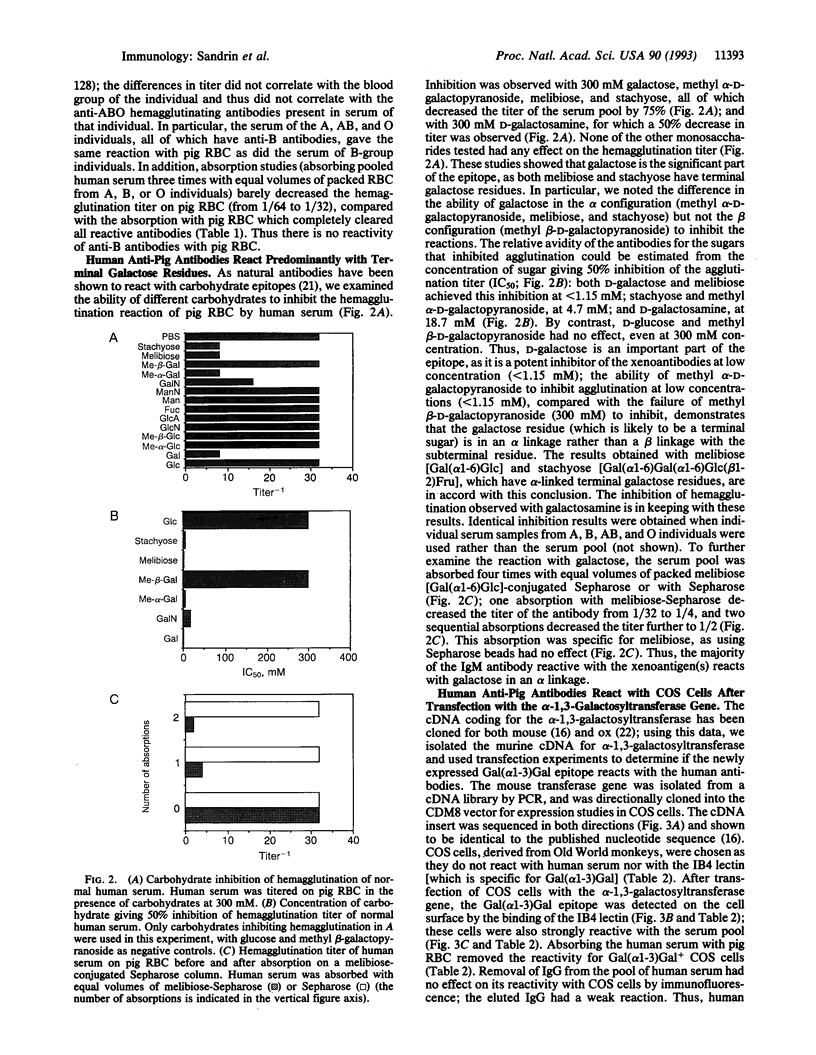
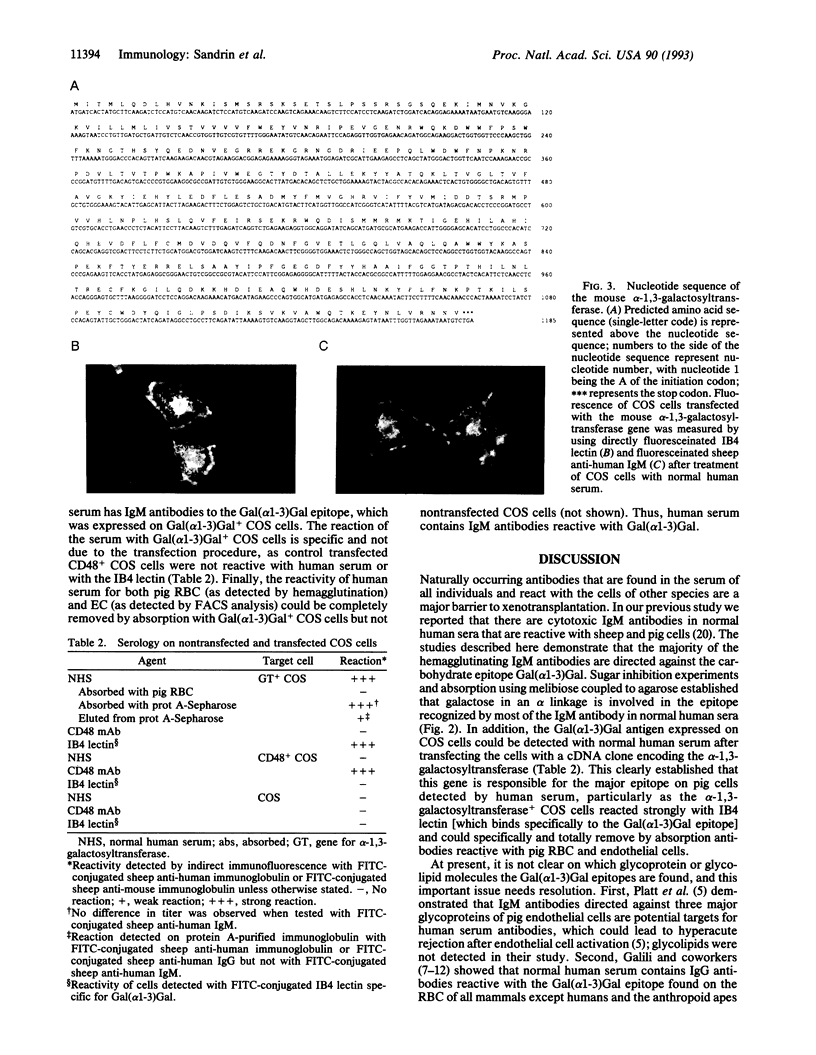
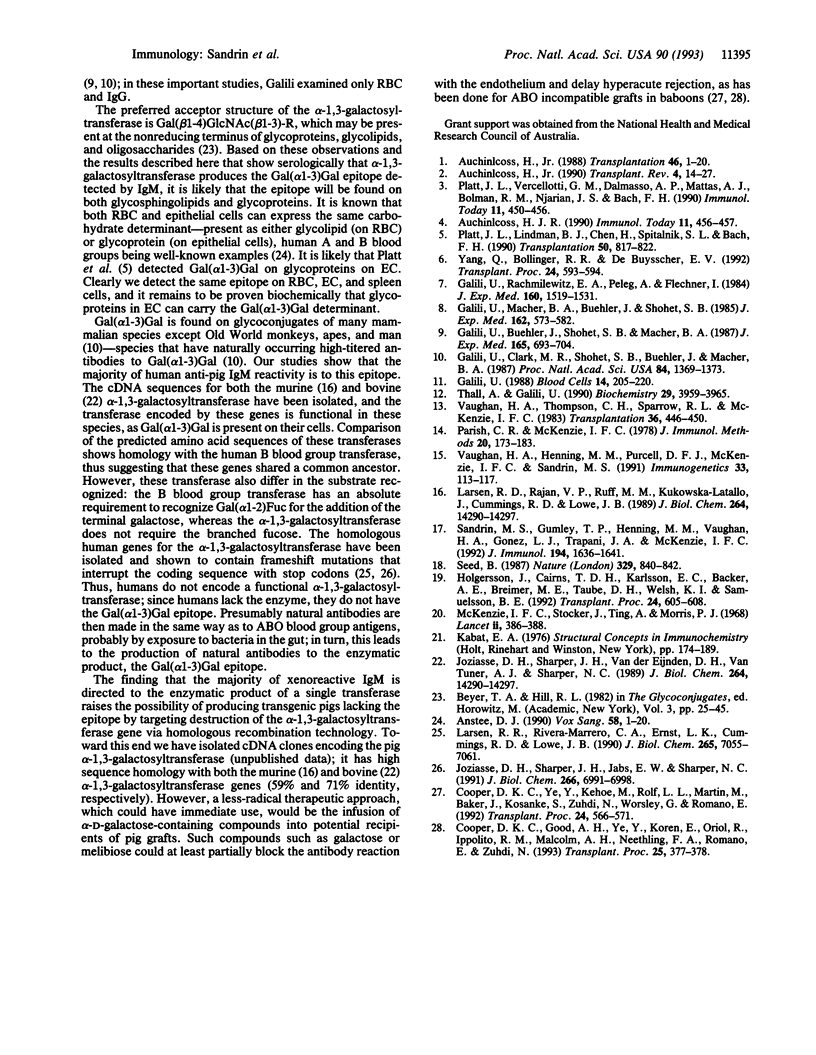
Images in this article
Selected References
These references are in PubMed. This may not be the complete list of references from this article.
- Anstee D. J. Blood group-active surface molecules of the human red blood cell. Vox Sang. 1990;58(1):1–20. doi: 10.1111/j.1423-0410.1990.tb02049.x. [DOI] [PubMed] [Google Scholar]
- Auchincloss H., Jr Xenogeneic transplantation. A review. Transplantation. 1988 Jul;46(1):1–20. doi: 10.1097/00007890-198807000-00001. [DOI] [PubMed] [Google Scholar]
- Cooper D. K., Good A. H., Ye Y., Koren E., Oriol R., Ippolito R. M., Malcolm A. J., Neethling F. A., Romano E., Zuhdi N. Specific intravenous carbohydrate therapy: a new approach to the inhibition of antibody-mediated rejection following ABO-incompatible allografting and discordant xenografting. Transplant Proc. 1993 Feb;25(1 Pt 1):377–378. [PubMed] [Google Scholar]
- Cooper D. K., Ye Y., Kehoe M., Niekrasz M., Rolf L. L., Jr, Martin M., Baker J., Kosanke S., Zuhdi N., Worsley G. A novel approach to "neutralization" of preformed antibodies: cardiac allotransplantation across the ABO blood group barrier as a paradigm of discordant transplantation. Transplant Proc. 1992 Apr;24(2):566–571. [PubMed] [Google Scholar]
- Galili U., Buehler J., Shohet S. B., Macher B. A. The human natural anti-Gal IgG. III. The subtlety of immune tolerance in man as demonstrated by crossreactivity between natural anti-Gal and anti-B antibodies. J Exp Med. 1987 Mar 1;165(3):693–704. doi: 10.1084/jem.165.3.693. [DOI] [PMC free article] [PubMed] [Google Scholar]
- Galili U., Clark M. R., Shohet S. B., Buehler J., Macher B. A. Evolutionary relationship between the natural anti-Gal antibody and the Gal alpha 1----3Gal epitope in primates. Proc Natl Acad Sci U S A. 1987 Mar;84(5):1369–1373. doi: 10.1073/pnas.84.5.1369. [DOI] [PMC free article] [PubMed] [Google Scholar]
- Galili U., Macher B. A., Buehler J., Shohet S. B. Human natural anti-alpha-galactosyl IgG. II. The specific recognition of alpha (1----3)-linked galactose residues. J Exp Med. 1985 Aug 1;162(2):573–582. doi: 10.1084/jem.162.2.573. [DOI] [PMC free article] [PubMed] [Google Scholar]
- Galili U., Rachmilewitz E. A., Peleg A., Flechner I. A unique natural human IgG antibody with anti-alpha-galactosyl specificity. J Exp Med. 1984 Nov 1;160(5):1519–1531. doi: 10.1084/jem.160.5.1519. [DOI] [PMC free article] [PubMed] [Google Scholar]
- Galili U. The natural anti-Gal antibody, the B-like antigen, and human red cell aging. Blood Cells. 1988;14(1):205–228. [PubMed] [Google Scholar]
- Holgersson J., Cairns T. D., Karlsson E. C., Bäcker A. E., Breimer M. E., Taube D. H., Welsh K. I., Samuelsson B. E. Carbohydrate specificity of human immunoglobulin-M antibodies with pig lymphocytotoxic activity. Transplant Proc. 1992 Apr;24(2):605–608. [PubMed] [Google Scholar]
- Joziasse D. H., Shaper J. H., Jabs E. W., Shaper N. L. Characterization of an alpha 1----3-galactosyltransferase homologue on human chromosome 12 that is organized as a processed pseudogene. J Biol Chem. 1991 Apr 15;266(11):6991–6998. [PubMed] [Google Scholar]
- Joziasse D. H., Shaper J. H., Van den Eijnden D. H., Van Tunen A. J., Shaper N. L. Bovine alpha 1----3-galactosyltransferase: isolation and characterization of a cDNA clone. Identification of homologous sequences in human genomic DNA. J Biol Chem. 1989 Aug 25;264(24):14290–14297. [PubMed] [Google Scholar]
- Joziasse D. H., Shaper J. H., Van den Eijnden D. H., Van Tunen A. J., Shaper N. L. Bovine alpha 1----3-galactosyltransferase: isolation and characterization of a cDNA clone. Identification of homologous sequences in human genomic DNA. J Biol Chem. 1989 Aug 25;264(24):14290–14297. [PubMed] [Google Scholar]
- Larsen R. D., Rivera-Marrero C. A., Ernst L. K., Cummings R. D., Lowe J. B. Frameshift and nonsense mutations in a human genomic sequence homologous to a murine UDP-Gal:beta-D-Gal(1,4)-D-GlcNAc alpha(1,3)-galactosyltransferase cDNA. J Biol Chem. 1990 Apr 25;265(12):7055–7061. [PubMed] [Google Scholar]
- McKenzie I. F., Stocker J., Ting A., Morris P. J. Human lymphocytotoxic and haemagglutinating activity against sheep and pig cells. Lancet. 1968 Aug 17;2(7564):386–387. doi: 10.1016/s0140-6736(68)90598-9. [DOI] [PubMed] [Google Scholar]
- Parish C. R., McKenzie I. F. A sensitive rosetting method for detecting subpopulations of lymphocytes which react with alloantisera. J Immunol Methods. 1978;20:173–183. doi: 10.1016/0022-1759(78)90254-5. [DOI] [PubMed] [Google Scholar]
- Platt J. L., Lindman B. J., Chen H., Spitalnik S. L., Bach F. H. Endothelial cell antigens recognized by xenoreactive human natural antibodies. Transplantation. 1990 Nov;50(5):817–822. doi: 10.1097/00007890-199011000-00015. [DOI] [PubMed] [Google Scholar]
- Platt J. L., Vercellotti G. M., Dalmasso A. P., Matas A. J., Bolman R. M., Najarian J. S., Bach F. H. Transplantation of discordant xenografts: a review of progress. Immunol Today. 1990 Dec;11(12):450–457. doi: 10.1016/0167-5699(90)90174-8. [DOI] [PubMed] [Google Scholar]
- Sandrin M. S., Gumley T. P., Henning M. M., Vaughan H. A., Gonez L. J., Trapani J. A., McKenzie I. F. Isolation and characterization of cDNA clones for mouse Ly-9. J Immunol. 1992 Sep 1;149(5):1636–1641. [PubMed] [Google Scholar]
- Seed B. An LFA-3 cDNA encodes a phospholipid-linked membrane protein homologous to its receptor CD2. 1987 Oct 29-Nov 4Nature. 329(6142):840–842. doi: 10.1038/329840a0. [DOI] [PubMed] [Google Scholar]
- Thall A., Galili U. Distribution of Gal alpha 1----3Gal beta 1----4GlcNAc residues on secreted mammalian glycoproteins (thyroglobulin, fibrinogen, and immunoglobulin G) as measured by a sensitive solid-phase radioimmunoassay. Biochemistry. 1990 Apr 24;29(16):3959–3965. doi: 10.1021/bi00468a024. [DOI] [PubMed] [Google Scholar]
- Vaughan H. A., Henning M. M., Purcell D. F., McKenzie I. F., Sandrin M. S. The isolation of cDNA clones for CD48. Immunogenetics. 1991;33(2):113–117. doi: 10.1007/BF00210824. [DOI] [PubMed] [Google Scholar]
- Vaughan H. A., Thompson C. H., Sparrow R. L., McKenzie I. F. Hu Ly-M3--a human leukocyte antigen. Transplantation. 1983 Oct;36(4):446–450. doi: 10.1097/00007890-198310000-00018. [DOI] [PubMed] [Google Scholar]
- Yang Q., Bollinger R. R., De Buysscher E. V. Xenoantigens expressed on swine erythrocytes, lymphoblastoid cells, and endothelial cells. Transplant Proc. 1992 Apr;24(2):593–594. [PubMed] [Google Scholar]



